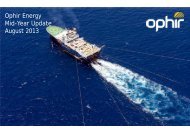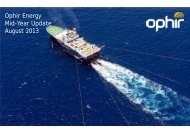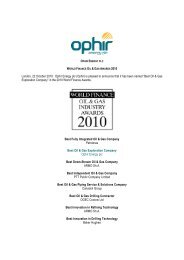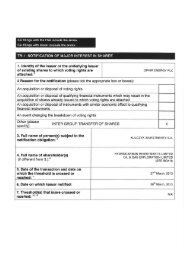Annual Report 2010 - Ophir Energy
Annual Report 2010 - Ophir Energy
Annual Report 2010 - Ophir Energy
Create successful ePaper yourself
Turn your PDF publications into a flip-book with our unique Google optimized e-Paper software.
Notes to the<br />
Financial Statements<br />
2.5 Exploration and evaluation<br />
expenditure<br />
The Company applies the successful efforts method of<br />
accounting for the exploration and evaluation (“E&E”) costs<br />
as permitted by IFRS 6 “Exploration for and Evaluation of<br />
Mineral Resources”.<br />
All costs incurred after the rights to explore an area have<br />
been obtained, such as licence acquisition costs, geological<br />
and geophysical costs and other direct costs of E&E are<br />
accumulated and capitalised as E&E assets, in well, field or<br />
licence-specific exploration cost centres as appropriate<br />
pending determination.<br />
Costs (other than payments to acquire the legal right to<br />
explore) incurred prior to acquiring rights to explore and<br />
general exploration costs not specific to any particular<br />
licence or prospect are charged directly to the income<br />
statement.<br />
E&E assets are not amortised prior to the determination<br />
of the results of exploration activity. At completion of<br />
evaluation activities, if technical and commercial feasibility<br />
is demonstrated, then, following recognition of commercial<br />
reserves, the carrying value of the relevant E&E asset will be<br />
reclassified as a development and production asset, subject<br />
to the carrying value of the relevant E&E asset being<br />
assessed for impairment.<br />
If on completion of evaluation of prospects or licences,<br />
it is not possible to determine technical feasibility and<br />
commercial viability or if the legal right to explore expires or<br />
if the Group decides not to continue E&E activity, then the<br />
costs of such unsuccessful E&E are written off to the income<br />
statement in the period of that determination.<br />
The carrying value of E&E assets are reviewed for<br />
impairment when events or changes in circumstances<br />
indicate the carrying value may not be recoverable.<br />
2.6 Intangibles<br />
Intangible assets are initially measured at cost. Following<br />
initial recognition, intangible assets are carried at cost less<br />
any accumulated amortisation and any accumulated<br />
impairment losses.<br />
Intangible assets with finite lives are amortised over the<br />
useful life and tested for impairment whenever there is an<br />
indication that the intangible asset may be impaired.<br />
2.7 Property, plant and equipment<br />
Property, plant and equipment, which comprises furniture<br />
and fittings and computer equipment, is stated at cost less<br />
accumulated depreciation and accumulated impairment<br />
losses. Such cost includes costs directly attributable to<br />
making the asset capable of operating as intended.<br />
Depreciation<br />
Depreciation is provided on property, plant and equipment<br />
calculated using the straight line method at rates to write<br />
off the cost, less estimated residual value based on prices<br />
prevailing at the Balance Sheet date, of each asset over<br />
expected useful lives ranging from 3 to 10 years.<br />
2.8 Investment in subsidiaries<br />
The Company holds monetary balances with its subsidiaries<br />
of which settlement is neither planned nor likely to occur in<br />
the foreseeable future. Such balances are considered to be<br />
part of the Company’s net investment in its subsidiaries.<br />
The carrying value of investments in subsidiaries are<br />
reviewed for impairment when events or changes in<br />
circumstances indicate the carrying value may not be<br />
recoverable.<br />
2.9 Trade and other receivables<br />
Trade receivables, which generally have 30 to 90 day terms,<br />
are recognised and carried at the lower of their original<br />
invoiced value and recoverable amount. Where the time<br />
value of money is material, receivables are carried at<br />
amortised cost. Allowance is made when there is objective<br />
evidence that the Group will not be able to recover balances<br />
in full. Evidence on non-recoverability may include<br />
indications that the debtor or group of debtors is<br />
experiencing significant financial difficulty, the probability<br />
that they will enter bankruptcy or default or delinquency in<br />
repayments. Balances are written off when the probability<br />
of recovery is assessed as being remote. The amount of the<br />
impairment loss is the receivable carrying amount compared<br />
to the present value of estimated future cash flows,<br />
discounted at the original effective interest rate.<br />
2.10 Inventories<br />
Inventories which comprise drilling consumables are stated<br />
at the lower of cost end net realisable value. Cost is<br />
determined by using weighted average cost method and<br />
comprises direct purchase costs, cost of transportation and<br />
other related expenses.<br />
47<br />
<strong>Ophir</strong> energy plc | <strong>2010</strong> ANNUAL REPORT<br />
Group accounts | notes to the financial statements<br />
2.11 Cash and short-term deposits<br />
Cash and short-term deposits in the Balance Sheet comprise<br />
cash at banks, in hand and short-term deposits with original<br />
maturity dates of up to twelve months.








